The Oppression of Muslim Minorities - Muslims Trying To Live By Their Religion
 |
In the previous chapters of this book we have considered countries with majority Muslim populations, and have examined the suffering inflicted on them by occupying powers or the oppressive administrations placed over them. However, there are also many countries in the world with minority Muslim populations. Many millions of Muslims are also suffering in such places as Myanmar, the Philippines, Cambodia and Thailand.
The cruelty that goes on in these countries is generally even more bloody and savage than that in other places. These people are unable to make their voices heard to the outside world, and are trying to survive despite the fact that in many cases they have lost all their means and had their land and goods stolen from them. Great efforts are being exerted to stop them from living by their religion, and the authorities are trying to assimilate them by means of pressure and despotism.
This chapter will provide details of the suffering inflicted in some of these countries, and will try to help these Muslims as they cry out for help.
Myanmar - Arakan Muslims Facing Violence
 |
Myanmar (formerly known as Burma) has a population of 48 million, 15 percent of whom are Muslims. Most of the rest are Buddhists. The Muslims live in the Arakan region of the country.
Arakan is the country's richest region in terms of oil and natural gas deposits, and its people first came to Islam by means of Arab merchants. This turning towards Islam culminated with the establishment of an Islamic state in 1430. This state survived for 350 years, until the Buddhists put an end to it by conquering Arakan.
Immediately after the Muslims lost political power in 1783, the Burmese Buddhist administrators embarked on a policy of oppressing and even physically eliminating them. The country was then colonized by the British towards the end of the nineteenth century.
The anti-Muslim campaign waged among the Myanmar people gained momentum in the twentieth century, and there was a terrible massacre in Arakan in 1942 which resulted in the deaths of 100,000 Muslims, and left hundreds of thousands either crippled or forced to flee their land.
Burma gained independence in 1948 with the end of British rule. Yet, the new rulers made life even more intolerable for Muslims. The communist general Ne Win, who came to power in a military coup in 1948, mobilized all the forces of the state to wipe out the Muslims. The "Burmese Socialist Party Program" aimed at using all possible means to turn Muslims away from their religion.
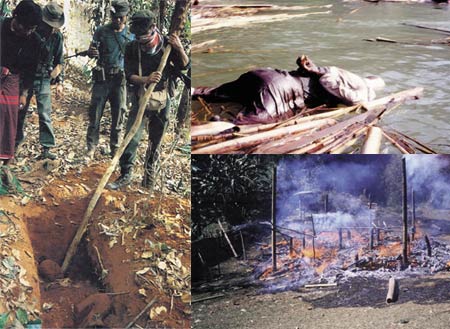 |
| The military regime in Myanmar began a full-scale war against the Muslims, with mosques, imams and devout believers particularly singled out for attack. Muslim students were forced to receive Buddhist education in the capital of Arakan. Muslim women were taken to camps, under the pretext of being given "professional training," and were then raped. Those who became pregnant were forced to marry members of the Buddhist security force. Villages were destroyed, houses turned into police stations, and those who were thus left homeless faced hunger and poverty. |
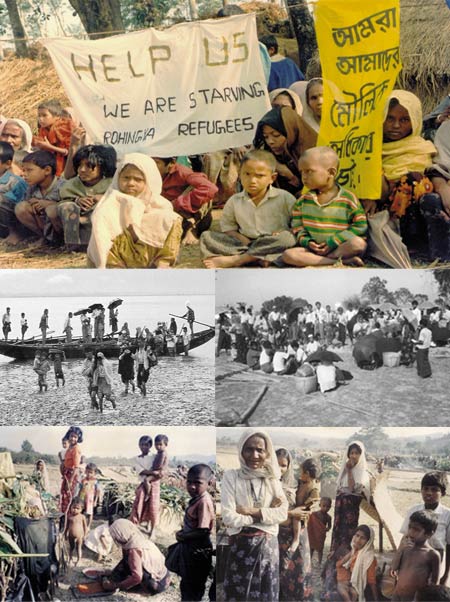 |
| In order to portray Arakan as a Buddhist province, the Ne Win government began a refugee operation under the name of "King Dragon." People living in small villages were herded into camps. Villages and mosques were destroyed, and there were many murders, rapes, arrests and incidents of torture. In 1978, some 200,000 Muslims abandoned Arakan and fled to Bangladesh. Yet the refugee camps in that country simply brought them poverty, hunger and disease. These pictures give an idea of the human suffering being lived out in the Rohingya refugee camps. |
The Dimensions of Cruelty (1942-1996) | |
| SETTLEMENTS DESTROYED | 10-15,000 |
| MIGRATION | AROUND 2 MILLION |
| MASSACRE | 200,000 |
| RAPE | 20,000 |
| MURDER | 20,000 |
| DETENTIONS | 40,000 |
| MOSQUES BURNT AND DESTROYED | 5,000 |
| DISAPPEARED | 50,000 |
| UNEMPLOYED OR WITH NO MEANS OF SUPPORT | 1 MILLION |
This meant Muslims being stripped of all their political rights. All Islamic educational facilities, mosques and similar places were also closed down. Mosques were turned into places of entertainment or Buddhist temples. Going on the pilgrimage (hajj), sacrificing animals, group prayer and other such forms of religious observance were all banned. On account of all this pressure, some of the Muslim population had to flee the country. Yet despite this emigration, the majority of the population of Arakan was still Muslim. Gen. Ne Win therefore stepped up the pressure, and turned to illegal arrests and torture towards this end. As a result of these ruthless practices, more than a million Muslims were obliged to leave Burma. In order to conceal the savagery that was being carried out, the Burmese government for many years refused to allow in foreign journalists and even tourists.
According to reports from international human rights organizations, some 20,000 Arakan Muslims were killed by this repressive regime between 1962 and 1984. Hundreds of women were raped and all the Muslims' belongings were confiscated. State communications were used to spread lies and slander about Islam. In 1978, the ravages of the army led to more than 200,000 Muslims having to flee to Bangladesh under the most difficult conditions. They returned under U.N. protection in 1979.60
Following the resignation of Ne Win in 1988, various military and civilian administrations came and went, and more than 3,000 people were killed in the uprisings that broke out during this period. In 1992 it emerged that 700 members of the Muslim minority living by the border with Bangladesh had been drowned. More than 1,000 people were the victims of extra-judicial killings in 1994.
The rape and torture inflicted on Muslim women in Myanmar still appear in human rights reports every year. Yet for some reason, the West's response is one of silent indifference.
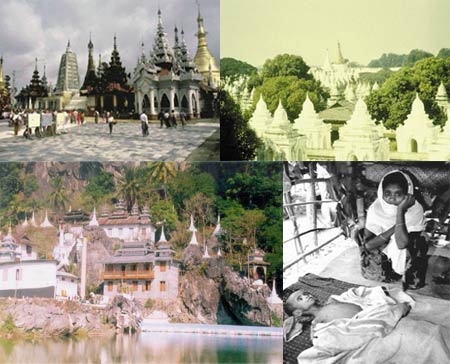 |
| Alongside the terrible poverty in the Rohingya refugee camps (below), Buddhists in Myanmar enjoy a life of plenty. |
One of the greatest problems facing the defenseless Muslim population in Myanmar is that they are unable to communicate with the outside world to make known what is being done to them. That is because the government forbids anyone to enter the country by land, and even though one can enter it by air, many regions are closed to foreigners. It is a most difficult task to establish the details of the suffering being inflicted on the Muslims of Myanmar.
Another wave of mistreatment took place in the 1990s, during which another 200,000 people had to flee to Bangladesh.61 Refugees fleeing the oppression in Myanmar find themselves facing terrible human dramas. Bangladesh is a very poor Muslim nation, and finds it difficult to feed and shelter refugees from Myanmar, although it does let them in.
All Muslims must hear the cries for help rising up from Myanmar and Bangladesh. In the Qur'an, Allah commands people to help the poor, those who are driven from their homes and those in need. It is the duty of all Muslims to prepare an environment in which those forced from their countries can be made comfortable, to make sacrifices in order to help them, and to show them support and love. Examples of this are given in the Qur'an, which reveals the proper attitude to be adopted by Muslims towards those driven from their homes:
It is for the poor of the emigrants who were driven from their homes and wealth desiring the favor and the pleasure of Allah and supporting Allah and His Messenger. Such people are the truly sincere. (Surat al-Hashr: 8)
Those who were already settled in the abode, and in belief, before they came, love those who emigrated to them and do not find in their hearts any need for what they have been given and prefer them to themselves even if they themselves are needy. It is the people who are safe-guarded from the avarice of their own selves who are successful. (Surat al-Hashr: 9)
As in the Qur'an Allah reveals, believers are those who offer the hand of friendship to those whom they love. When this praiseworthy morality comes to be widely practiced throughout the world, then the poverty and other problems facing the refugees will all be solved.
The Philippines - The Muslims of Bangsa Moro and Marcos' Cannibals
 |
Most people may not be aware that the Philippines have a large Muslim population, and that these people have been fighting oppression, torture and inhumane policies for many years. Yet Muslims in the Philippines have been savagely slaughtered for years, and are waiting for help from the Muslims of the world to allow them to survive.
Some 90 percent of Filipinos are Catholic, although the situation is very different in the southern islands, where the population is 70 percent Catholic and 30 percent Muslim. The latter consist of the Moros of the island on Mindanao and the Muslims on the island of Sulu. Muslims make up 97 percent of the people of Sulu.62
The origins of the conflict in the Philippines go back to 1946, when the country gained independence after years of U.S. rule. Unlike the Muslims on Mindanao and Sulu, the majority Christian population of the Philippines offered no resistance to the colonialist American administration and accepted the governors imposed on them. The Americans educated Filipino leaders in order to establish a pro-U.S. administration. When the United States finally withdrew, it therefore left power in the hands of the Filipinos, and accepted Mindanao and Sulu as parts of a single unitary state. So the Muslims on those islands were subjected to Filipino rule.
The Filipinos embarked of a policy of reinforcing their supremacy, and in particular of taking away the lands of the Muslim Moros. A new law allowed a Filipino to take over 24 hectares of land, but this was limited to 10 hectares in the case of the Moros. The result was a wave of Filipino migration towards land populated by Muslims. That in turn had the effect of reducing the size of the Muslim majority. In the decade between 1966 and 1976, 3.5 million Filipino immigrants settled in Muslim lands.
On May 1, 1968, Cotabato Governor Datu Udtog Matalam set up the "Muslim Independence Movement" (MIM), which sought to compromise with the central authority under President Ferdinand Marcos. However, it failed to gather much support, and soon faded from the scene. The central government did not underestimate the importance of this development, and saw it as an opportunity to increase the pace of its anti-Moro policies. At the same time, Marcos declared himself head of the Philippines' Armed Forces. A short while later he announced martial law, justifying this by citing the terrorist movement set up by communists in the country, together with the Muslim resistance. He then suspended the Constitution, and finally become dictator over the whole country.
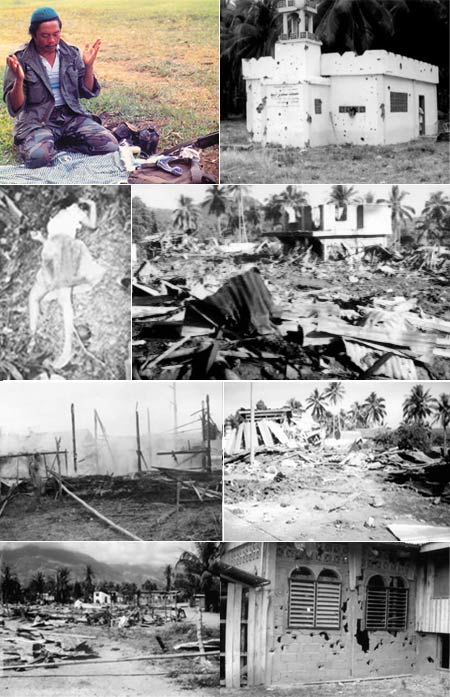 |
| The history of the Moro Muslims in the Philippines is rife with savagery and massacres. During the Marcos regime villages were burned, mosques with people inside bombed, and mass rapes perpetrated. Even today attacks and abuses still occur, and the conflict has been going on for years. All the Moro Muslims want is peace and security, and to set up an independent state in which they can live freely according to their religion. |
From that moment on, Marcos initiated mass killings against the Muslims, who had begun a struggle for independence. Some 50,000 Muslims were slaughtered, including perhaps 10,000 women and children. The Muslim resistance to Marcos was organized by a number of young people who had received training in the Middle East in the 1960s. The sudden and widespread emergence of the Moro National Liberation Front (MNLF) under the leadership of Nur Misuari took the Marcos regime by surprise. There followed bloody fighting between government forces and members of the MNLF.
Marcos set up specially trained terror teams to put an end to the popular support for the opposition in the country, particularly that of the MNLF. These teams, the most ruthless of which was called Ilaga, resorted to the most terrible methods. Turkish magazine Nokta had the following to say in an article entitled "Marcos' Cannibals":
They were stamping on Mrs Kassam's husband. Bits of brain were spurting out from his skull. Other armed militiamen were falling over themselves to grab the bits. Members of Ilaga think that drinking the blood and eating the flesh of their enemies makes them invincible. What a terrible invincibility!.. The members of Ilaga, which was set up in the 1970s during the Muslim uprisings, tortured thousands of Muslims to death during that time. They believed that they acquired supernatural powers by drinking the blood or eating the flesh of those they killed ... They would raid villages and slaughter people. The attacks then just turned into looting and pillaging. A bottle full of human ears was recently found in a village on Mindanao, the owners of which have yet to be identified.63
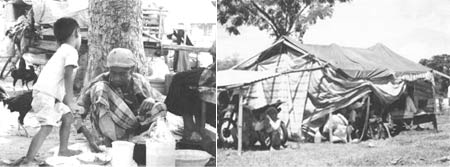 |
| Western media organizations are today giving biased coverage of the events in the Philippines, and the terrible suffering being inflicted on defenceless Muslims is being ignored. Yet those suffering the real violence and cruelty are Muslim Filipino women, children and the elderly. |
Muslim villages were burned during these raids, and the Moros' belongings plundered. Yet very little changed for the Muslims when Marcos was overthrown in a popular revolt in 1986. His successor, Corazon Aquino, planned to intimidate and eliminate them by other means. During Aquino's rule, the insurgents and military operations were intensified and the administration openly declared war against the Muslim movement. A "total war policy" was adopted by President Aquino, resulting to a displacement of more than a million Filipinos. School buildings and churches were used as venues for the fleeing families.64
The oppression of the Muslims continued after Aquino. Relations then improved for a short while, before growing tense again when mosques were bombed in 1994. On the other hand, the fact that a radical, pro-terror organization put down roots among Muslims at the same time worsened the problem. A solution to the problems in the Philippines will only be possible if the Manila administration abandons its decades-old policies of oppression and recognizes the rights of the Muslims in the south, and if the terrorist movements which have emerged claiming to represent the Muslims but which actually only do them harm are stopped.
Cambodia - Years-old Hatred of Islam
 |
The tiny, impoverished country of Cambodia lies in Asia, between India and China, in a region known as Indochina. Most of the country's people are illiterate and have for centuries relied on agriculture to survive. The most important element of that agriculture is the rice paddies stretching from one end of the country to the other.
By far the greater part of the population consists of Khmers, the oldest ethnic group in the area, with substantial Chinese and Buddhist minorities. Muslims form yet another minority.
Islam came to Cambodia by sea, carried by Muslim merchants and travelers. Most of the Muslims in Cambodia are of Thai origin, from a kingdom which was destroyed in wars and uprisings. Although, until 1975, there were still some 75 historic mosques.
We have already examined communism's hatred of religion and the terrible slaughter communists have wreaked on Islamic lands. The fiercely Maoist Khmer Rouge regime in Cambodia, which came to power with Chinese support, was one example of this. During the regime's days in power, there was an attempt to break all the Muslims' links with Islam.
The Khmer Rouge was a communist group formed and led by a Maoist called Pol Pot. They spent years in the jungles of Cambodia dreaming of coming to power, and in 1975 it finally happened. After taking over the country, they set up a cruel and totalitarian regime, the like of which had never before been seen. The Khmer Rouge regime decided that the sole national duty of a communist was to work to death in the rice paddies, and so began to force the whole population of the country to labor in them. Tens of thousands of people living in the cities – politicians, civil servants, teachers and intellectuals – were sent off to villages and made to work in collectives under truly terrible conditions.
Stopping to rest during working hours, eating even a tiny part of what was harvested without permission, or practicing any form of religion at all were all considered "activities against the state," and thus the killing began. Between 1975 and 1979, the rice paddies turned into the infamous "killing fields." Some 3 million people out of the total population of 9 million were killed by being shot, or axed in the head, or suffocated, or else left to starve.
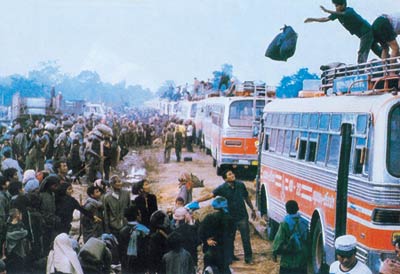 |
| Muslims in Cambodia are not allowed to live by their religion, use the Arabic alphabet, or perform their prayers. Those who violate these prohibitions are severely punished or executed. The people are growing ever poorer: Their personal belongings have been confiscated by the state and their rights taken away. They have no means of resisting the oppression of the Cambodian government. The only option left for them is to flee. This picture shows Muslims fleeing that oppression under very difficult conditions. |
As in all communist countries, a savage policy of repression was implemented against the Muslim population. War was declared on the people's religious values, and the regime resorted to violence in an effort to turn people away from their religion. Hundreds of thousands of Muslims were killed. The figures speak for themselves: Some 200,000 Muslims live in Cambodia today. The figure was more than 800,000 before the communist revolution, when Muslims represented 7 percent of the population.
The Black Book of Communism describes the savagery the Khmer Rouge employed against the Muslim Cham people:
In 1973, mosques were destroyed and prayers banned in the liberated zones. Such measures became more widespread after May 1975. Korans were collected and burned, and mosques were either transformed into other buildings or razed. Thirteen Muslim dignitaries were executed in June, some for having gone to pray rather than attending a political rally, others for having campaigned for the right to religious wedding ceremonies… The more fervent were all but wiped out: of the 1,000 who had made the pilgrimage to Mecca, only 30 survived these years. Unlike other Cambodians, the Cham frequently rebelled, and large numbers of them died in the massacres and reprisals that followed these uprisings. After mid-1978 the Khmer Rouge began systematically exterminating a number of Cham communities, including women and children… Ben Kiernan calculates that the overall mortality rate among the Cham was 50 percent.65
Some 70 percent of the Muslims living in the capital, Phnom Penh, abandoned the country because of the terrible savagery of the Khmer Rouge and were forced to seek shelter in neighboring countries such as Thailand, Malaysia and Laos. When the Vietnamese occupied Cambodia in 1979, the Khmer Rouge regime came to an end, although the repression of Muslims continued unabated. The Vietnamese government, supported by the Soviets, carried on with the cruelty of the Khmer Rouge. They employed the most repressive policies in order to eliminate Islam entirely. The few places of worship left to the innocent Muslims subjected to Vietnamese assaults were torn down, and religious figures were killed. Most of them were horribly tortured in prison and used as forced labor.
Even today, it is still forbidden to spread Islam or to communicate with Cambodians in other countries. Like many other features of Islamic religious life, group worship is banned. The Vietnamese also destroyed all the historic artifacts they came across. There are currently only 20 small mosques still standing in Cambodia.
Tens of thousands of human bones and skulls of people killed by the Khmer Rouge, including Muslims, are now on display in a museum in Phnom Penh. Just as with Chechnya and East Turkestan, the events in Cambodia expose to the world the true face of communist savagery.
Tanzania - Pressure Cannot Halt the Rise of Islamic Consciousness
 |
Muslims came to the central-southeastern African country of Tanzania from the Indian subcontinent. As a result of their missionary activities, the local population abandoned paganism and accepted Islam. There are Muslims in all 120 tribes in Tanzania.
Although more than half the population is Muslim (some 55 percent), Muslims are still treated as a minority. Christians form a minority of the population but hold the reins of power. Only six out of 23 government ministries are held by Muslims. Muslims may represent more than half of the population, but the country is still described as half Christian and half "local religions." The 9 million Muslims are also facing a systematic policy of Christianization. Students who fail to abide by Christian rules in middle schools are expelled. In the same way that Islamic bodies and organizations are forbidden, so too is spreading Islam. The government has also banned the learning of Arabic and going on the hajj. Despite this policy of the Tanzanian government, however, the number of Muslims in the country is growing every day.
One of the government's policies aimed at Christianizing the population is the attempt to establish a mixed Islamic/Christian belief system under the name of the Islamic Renewal Movement. The people are tools, and as part of this policy they are told that there is no need to carry out many of the basic tenets of Islam. Those who oppose these twisted beliefs are either thrown into prison, or killed, or made to leave the country.
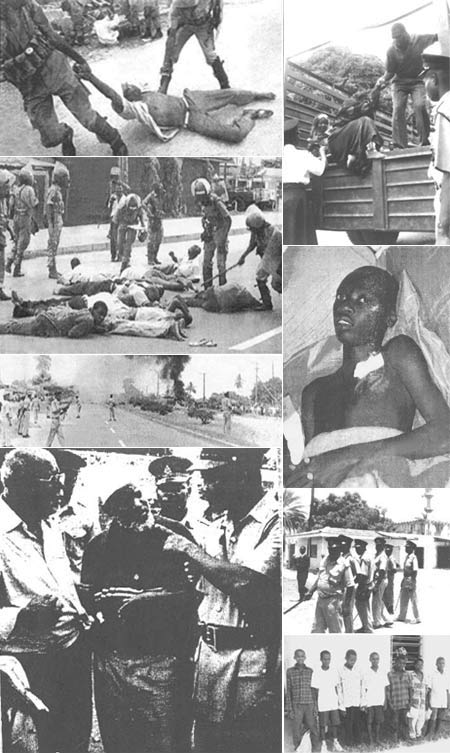 |
| The Christian regime in Tanzania employs harsh violence against the majority Muslim population. The only reason for the fighting shown in the pictures is that the people are Muslims. Some people are assaulted by the police just for having a copy of the Qur'an in their cars or for performing group prayers. Young people who wish to live by their religion are prevented from studying it. Disseminating Islam, learning Arabic and going on the hajj are banned in Tanzania, although the number of Muslims in the region is increasing, despite the government's policies. |
Sri Lanka - Terrorism Aimed at Muslims
 |
Sri Lanka is an island nation in the Indian Ocean with a Muslim population of some 2.6 million Muslims. The Tamil guerillas waging war against the administration sometimes also attack Muslim villages and kill innocent civilians. One recent massacre took place in the village of Mawanella, which was completely destroyed on May, 3, 2001. The Sri Lankan Muslims have prepared a website to try to have their voices heard by the outside world, and in it they describe the suffering they are subjected to in these terms:
... We Muslims are, basically, a trading and business community, with a recent incursion to the various professions in many fields. Our contribution to the development and progress of Sri Lanka have always been positive and we have, since ancient times, maintained a very cordial and friendly relationship with all of the other communities amongst whom we live.
The Tamil Tiger separatist issue has brought about much hardship and torment to many Muslims living in the affected areas of the North and the East. Of late a small sector of the Sinhalese community has also taken up arms against Muslims, attacking our businesses, mosques, and personal lives.
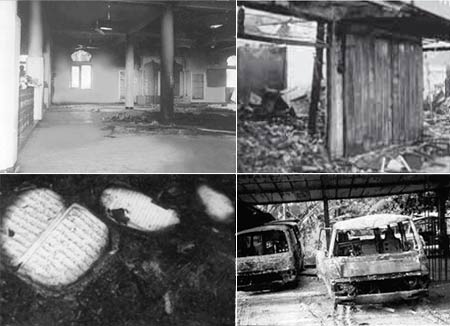 |
| The Muslims of Sri Lanka suffer fresh attacks, abuses and pillaging every day. On a website they set up to make their voices heard to the outside world, they say that the only thing they want is to be able to live by their religion in freedom, to bring their children up in that faith, and to live a life of peace and security. Despite that, however, daily assaults have become a regular feature of their lives. |
We are a minority community that seeks to live and let live and maintain a peaceful co-existence between all other communities, ensuring that we are allowed to practice our religion and maintain our social standing in the way it has been throughout history... We are not a community that is interested in separatism and terrorism like the Tamils. We do not seek to antagonize and shower hatred between the various communities... All we seek is a decent life where we can live peacefully and comfortably, continue our worship of the Almighty, carry out our businesses and professions, and educate and raise our children honorably. 66
The above extracts are a statement of the strong Islamic awareness of the Sri Lankan Muslims. Yet for many years they have been unable to find the peace and security they have sought. In the latest attacks, for instance, racist Sri Lankan Buddhists gathered up copies of the Qur'an and other Islamic writings, including a number of rare, centuries-old texts, and burned them all in front of a mosque. Two mosques were burned down and more than 90 Muslim-owned buildings were destroyed.
Ali Sahir Moulana, a Muslim opposition parliamentarian, says that three mosques, 60 houses, 80 shops and two gas stations all belonging to Muslims were burned by the mobs. He also claims that the attacks were carried out in order to inflict economic damage on the Muslims of Mawanella.
Patani - Inhumane Violence Meted Out to Muslims by the Thai Government
 |
The mountainous and forested region of Patani is the richest in Thailand, and the origin of fully 35 percent of the country's exports. Patani's Muslims, however, who make up 10 percent of the nation's total population of 55 million, have been oppressed for the last 200 years, and now face a policy of genocide.
The suffering of the Patani Muslims first began in 1782 when the Rama Dynasty came to power in Patani. The dynasty moved its capital to Bangkok and set up a modern administrative system. At just that time, fighting broke out between the Patani Muslims and local people known as the Siamese, and it continued for several days. Many Patani cities were burned, its military headquarters was destroyed, and some 4,000 Patani Muslims were taken prisoner by the Siamese during the course of the fighting.
The Siamese savagely tortured those prisoners, bringing them to Bangkok bound to each other with rope threaded through their ears and legs with a needle, and putting them to work digging a canal with no tools or equipment.67 Patani's sultan was also brutally killed by the Siamese. Thailand was divided into seven regions after the war, and Patani made to pay taxes, spending the next 70 years under Siamese rule. The Patani Muslims claim that they are not of the Siamese race, and that they are not Thai but rather Indonesian and Malaysian. In fact they speak Malay, the language of the Malaysian Muslims. Although that language has been written in the Arabic alphabet for hundreds of years, they have been obliged to use Roman letters by the Thai government.
In 1909, the Siamese granted Patani so-called independence, although the repressive policies of the Thai government continued without change. The Muslims of Patani rose up to demand true independence many times, but were always brutally put down, resulting in a wave of migration to Malaysia.
The Thai rulers followed a policy of repression and assimilation aimed at doing away with Patani's Islamic identity. The first such measure came in 1932, when Muslim educational organizations were banned from carrying out any activities. A wide-ranging policy of extermination was initiated in 1944, and leading Patani Muslims and their families were brutally murdered by Buddhists. It was forbidden to abide by the tenets of Islam, and Buddhism began to be imposed on the people. The teaching of Buddhism became compulsory in schools, and Muslim students were even forced to behave according to Buddhist teachings.
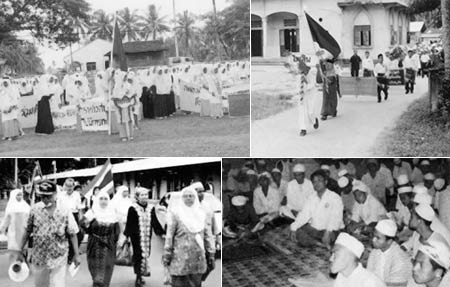 |
| More than 36,000 Muslims have been killed so far in the slaughter in Patani. The number of people injured and crippled is even higher. The Patani Muslims are still fighting to defend their Islamic identity. |
Over the years Thai rulers have perpetrated terrible massacres of the Patani Muslims. In 1944, 125 Muslim families were burned alive in the village of Belukar Samak alone. The assimilation policies imposed by the Thais were seen and felt in all aspects of daily life. Many minarets were torn down in Patani.
As part of this policy of assimilation, the demographic balance in the Patani region was also changed as Buddhists were encouraged to migrate there. The largest Buddhist statue in Thailand was erected in Patani, and Muslims were forced to worship it. Those who refused were killed or thrown into the Kota River.
During that same time, Patani freedom fighters' shelters were destroyed by the Thais and thousands of innocent Patanis were tortured. Prominent Muslim scholars died under suspicious circumstances in health centers set up by the Thai administration, and unsolved killings and disappearances became part of everyday life.
The struggle for independence of the Patani Muslims, who have experienced such great suffering, began after World War II and continues to this day.
Footnotes
60- George Lombard (United Nations High Commissioner for Refugees), "The Burmese Refugees in Bangladesh: causes and prospects for repatriation", (http://www.nectar.or.th/thai-yunnan/19html#5)
61- United Nations General Assembly, Document no: A/49/594, 28 October 1994, Situation of Human Rights in Myanmar (http://www.unhchr.ch/Huridocda.nsf/TestFrame/8fd07/ee2aafa951280256700003e9ad3?Opendocument)
62- Le Monde Diplomatique, July 2000, Islam contestataire aux Philippines, Solomon Kane, Laurent Passicousset
63- Nokta (Turkish Magazine), Marcos'un Yamyamları, (Marcos' Cannibals) 18 August 1985, pp. 36-37 (emphasis added)
64- Ray Francis Galuna, Lea Madulid, Allison Magcawas, and Archimedes Sy, "Muslim Insurgency in Mindanao." (www.geocities.com/archie_cute/Smuslim. htm)
65- S. Courtis, N. Werth, J. L. Panne, A. Paczkowski, K. Bartosek, J. L. Margolin, The Black Book Of Communism, pp. 594-595 ; Ben Kiernan, Pol Pot Regime: Race, Power and Genocide in Cambodia under the Khmer Rouge, 1975-1979, NewHaven, Yale University Press, 1996, pp. 428-431 (emphasis added)
66- http://mawanella.all-saudi.com/ (emphasis added)
67- Y. Ziya Comert, Patani Dosyası, (The Patani File), Akabe Publications, Istanbul, p. 37 (emphasis added)
- Foreword
- Introduction - A Call To All People of Conscience ...
- Danger Facing The Islamic World - The Anti-Islamic Alliance Facing Muslims
- Chechnya - Oppression as The Whole World Watches
- Kashmir - The Muslims of Kashmir are Waiting for Help
- East Turkestan - Savagery hidden by the communist Chinese Government
- Bosnia, Kosovo and Macedonia - The peoples of the Balkans dragged from one war to Another
- Algeria - The Bloody Toll of Endless Cruelty and Oppression
- Tunisia - A People Oppressed Solely for Their Faith
- Eritrea and Ethiopia - Muslims Want Peace and Security
- Chad - The Muslim country the colonialist French administration tried to destroy
- Somalia - A Poor Nation in the Midst of Civil Wars
- Djibouti - Oppression in Africa’s Smallest Country
- Sudan - A Country Trying To Escape Fighting and Civil War
- Uzbekistan - Former Communists Continue To Oppress Muslims
- Afghanistan - Endless Civil Wars Due To Communist Savagery
- Iraq - Middle East Fascism: Saddam Hussein
- Syria - The History of Terrible Oppression Hidden from The World
- The Oppression of Muslim Minorities - Muslims Trying To Live By Their Religion
- Conclusion
